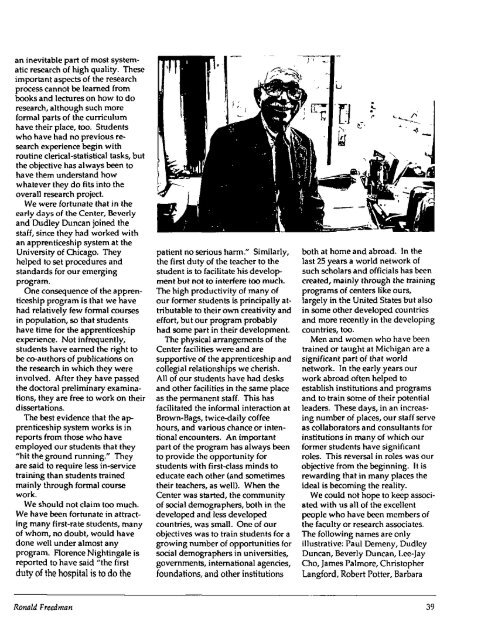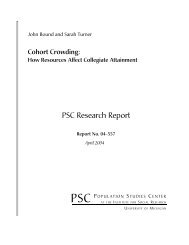1985-1987 - Population Studies Center - University of Michigan
1985-1987 - Population Studies Center - University of Michigan
1985-1987 - Population Studies Center - University of Michigan
Create successful ePaper yourself
Turn your PDF publications into a flip-book with our unique Google optimized e-Paper software.
an inevitable part <strong>of</strong> most systematicresearch <strong>of</strong> high quality. Theseimportant aspects <strong>of</strong> the researchprocess cannot be learned frombooks and lectures on how to doresearch, although such moreformal parts <strong>of</strong> the curriculumhave their place, too. Studentswho have had no previous researchexperience begin withroutine clerical-statistical tasks, butthe objective has always been tohave them understand howwhatever they do fits into theoverall research project.We were fortunate that in theearly days <strong>of</strong> the <strong>Center</strong>, Beverlyand Dudley Duncan joined thestaff, since they had worked withan apprenticeship system at the<strong>University</strong> <strong>of</strong> Chicago. Theyhelped to set procedures andstandards for our emergingprogram.One consequence <strong>of</strong>the apprenticeshipprogram is that we havehad relatively few formal coursesin population, so that studentshave time for the apprenticeshipexperience. Not infrequently,students have earned the right tobe co-authors <strong>of</strong> publications onthe research in which they wereinvolved. After they have passedthe doctoral preliminary examinations,they are free to work on theirdissertations.The best evidence that the apprenticeshipsystem works is inreports from those who haveemployed our students that they"hit the ground running." Theyare said to require less in-servicetraining than students trainedmainly through formal coursework.We should not claim too much.We have been fortunate in attractingmany first-rate students, many<strong>of</strong> whom, no doubt, would havedone well under almost anyprogram. Florence Nightingale isreported to have said "the firstduty <strong>of</strong> the hospital is to do thepatient no serious harm." Similarly,the first duty <strong>of</strong> the teacher to thestudent is to facilitate his developmentbut not to interfere too much.The high productivity <strong>of</strong> many <strong>of</strong>our former students is principally attributableto their own creativity andeffort, but our program probablyhad some part in their development.The physical arrangements <strong>of</strong> the<strong>Center</strong> facilities were and aresupportive <strong>of</strong> the apprenticeship andcollegial relationships we cherish.All <strong>of</strong> our students have had desksand other facilities in the same placeas the permanent staff. This hasfacilitated the informal interaction atBrown-Bags, twice-daily c<strong>of</strong>feehours, and various chance or intentionalencounters. An importantpart <strong>of</strong> the program has always beento provide the opportunity forstudents with first-class minds toeducate each other (and sometimestheir teachers, as well). When the<strong>Center</strong> was started, the community<strong>of</strong> social demographers, both in thedeveloped and less developedcountries, was small. One <strong>of</strong> ourobjectives was to train students for agrowing number <strong>of</strong> opportunities forsocial demographers in universities,governments, international agencies,foundations, and other institutionsboth at home and abroad. In thelast 25 years a world network <strong>of</strong>such scholars and <strong>of</strong>ficials has beencreated, mainly through the trainingprograms <strong>of</strong> centers like ours,largely in the United States but alsoin some other developed countriesand more recently in the developingcountries, too.Men and women who have beentrained or taught at <strong>Michigan</strong> are asignificant part <strong>of</strong> that worldnetwork. In the early years ourwork abroad <strong>of</strong>ten helped toestablish institutions and programsand to train some <strong>of</strong> their potentialleaders. These days, in an increasingnumber <strong>of</strong> places, our staff serveas collaborators and consultants forinstitutions in many <strong>of</strong> which ourformer students have significantroles. This reversal in roles was ourobjective from the beginning. Itisrewarding that in many places theideal is becoming the reality.We could not hope to keep associatedwith us all <strong>of</strong> the excellentpeople who have been members <strong>of</strong>the faculty or research associates.The following names are onlyillustrative: Paul Demeny, DudleyDuncan, Beverly Duncan, Lee-JayCho, James Palmore, ChristopherLangford, Robert Potter, BarbaraRonald Freedman 39















